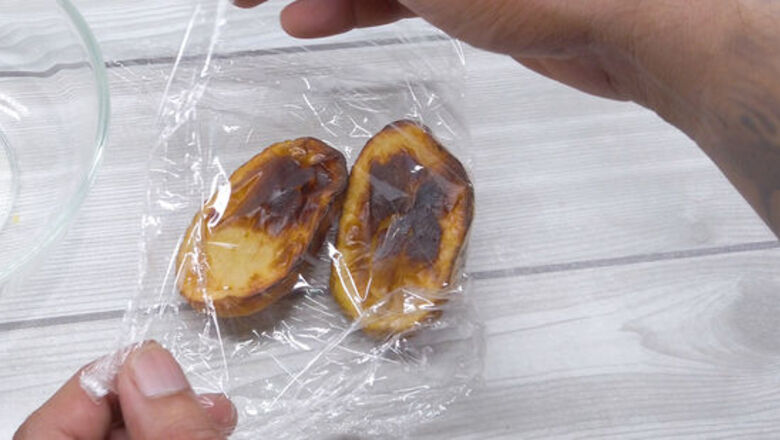
views
Saving Cooked Potatoes
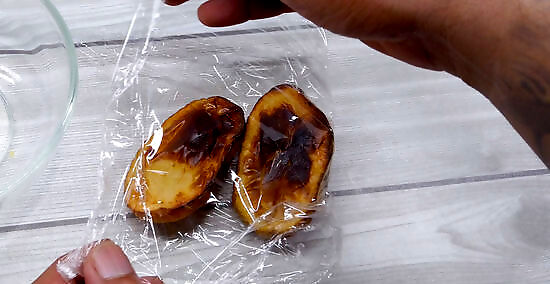
Wrap baked potatoes in plastic cling wrap, then freeze for up to 4 weeks. Take the baked potato and scoop out the inside. Then, mash up the inside of the potato and put it back inside the skin. Pull off a sheet of plastic wrap and layer it tightly around the potato. Place the potato in the freezer until you’re ready to serve it. Eat your baked potato within 4 weeks for best taste. Scooping out the inside of the potato and mashing it will improve the texture once you reheat it.
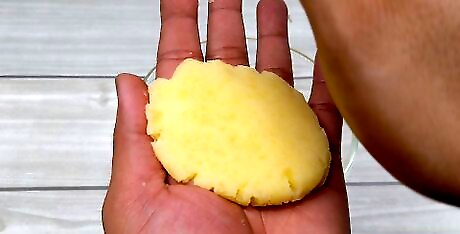
Freeze mashed potatoes in .5 in (1.3 cm) thick patties on a baking sheet. Use your hands to mold your leftover mashed potatoes into .5 in (1.3 cm) thick patties. Place the patties on a baking sheet, then cover it with plastic cling wrap. Put the mashed potatoes into the freezer for about 24 hours. Then, combine the mashed potato patties into a single airtight container. It’s best to eat them within a few weeks, as mashed potatoes don’t freeze well.
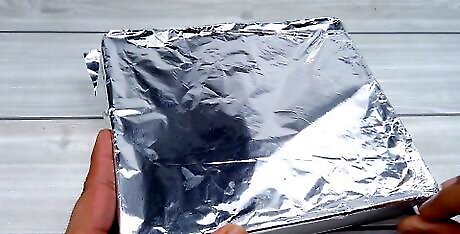
Keep scalloped potatoes or potato casserole in the baking dish when freezing. Cool the dish evenly by putting it in your refrigerator for about 1-2 hours. Cover the food with moisture-resistant parchment paper, then cover it again with a lid or aluminum foil. When you're ready to reheat the dish, you can thaw it or put it directly into the oven while it's still frozen. These types of potato dishes can be reheated in an oven at 400 °F (204 °C) for 25-30 minutes. If you have one, use a food thermometer to make sure the dish's internal temperature is at least 165 °F (74 °C). If you're making the recipe with the intention of freezing it, stop cooking the dish when it has a light brown color and the potatoes feel almost tender.
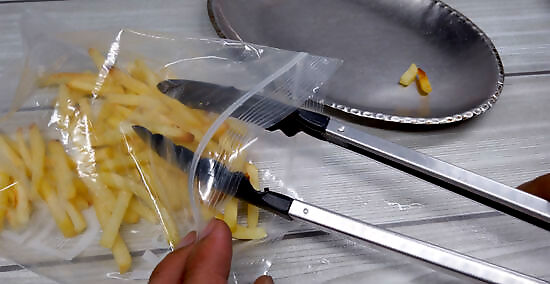
Cool french fries in the refrigerator, then pack in an airtight container. Bake the french fries as you normally would. Before freezing them, place them in your refrigerator to cool for about half an hour. Then, put them into an airtight container and freeze. Your french fries will keep better if you chill them before your freeze them. This also helps keep them safe to eat because the fries will cool evenly. Enjoy your cooked fries within 4 weeks for best taste.
Preserving Raw Potatoes
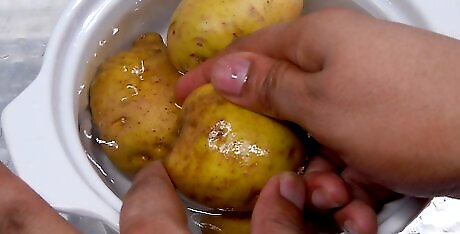
Scrub the potatoes to remove any dirt. Wet the potato with warm water, then use your hand or a vegetable scrub brush to clean the potato. Be sure to get into any dips or rough spots to remove any stuck-on dirt. If you’re peeling the potatoes, you might skip this step. However, it’s helpful to start with a clean skin so that you don’t accidentally transfer dirt from the skin onto the edible part of the potato.
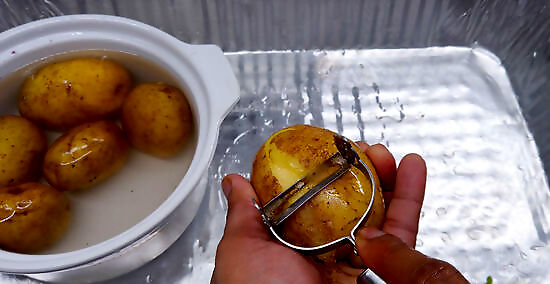
Peel or cut russet potatoes, for best results. Blanching works best if the skin isn’t protecting the potato. However, you can freeze potatoes in the skin if you prefer. If you want to save the skin, it’s best to cut the potatoes before you freeze them. Depending on how you plan to use your potatoes, it’s okay to freeze them whole, chop them in half, chop them into cubes, or slice them for french fries.Tip: If you want to use your potatoes for french fries, chop them to your desired size using a sharp knife or a french fry cutter.
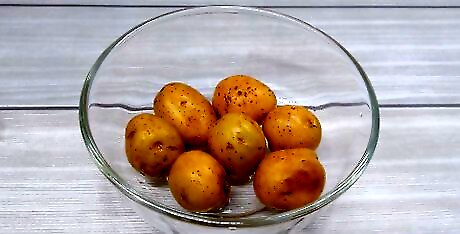
Leave red and gold potatoes whole, or chop them up if you prefer. Red and gold potatoes are easier to freeze than russet potatoes because they will blanch well whole, even with their skin. If you’d prefer to chop them up so they’ll be ready to cook later, use a sharp knife to cut them into cubes or slices. If you prefer, it’s okay to peel your red and gold potatoes before you freeze them.
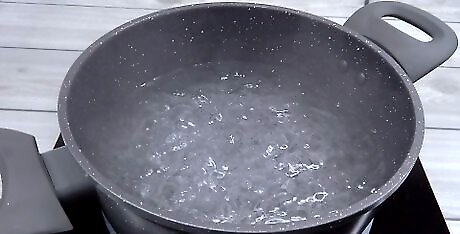
Bring a pot of water to boiling over high heat. Place the pot of water on the stove, then turn the heat to high. Watch for bubbles rising from the bottom to the top, which means the water is boiling. You should see consistent bubbling on top of the water when it’s boiling.Tip: As a good rule of thumb, use about 1 gallon (3.8 L) of water for every 1 pound (0.45 kg) of potatoes you’re blanching. If you have a lot of potatoes, it’s a good idea to do them in small batches.
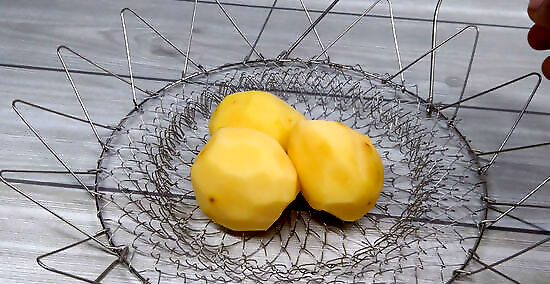
Place your potatoes in a blanching basket. Put a single layer of potatoes on the bottom of the blanching basket. This will ensure that they’re able to cook in the time allotted. Blanching too many potatoes at once can prevent them from cooking well. It’s okay to do several batches of blanching. It’s better to do extra batches than to ruin a batch of potatoes by not blanching them right.Variation: If you don’t have a blanching basket, it’s okay to put the potatoes directly into the water. However, you’ll need to be able to scoop them out of the water quickly once they’re finished blanching with a slotted spoon or tongs.
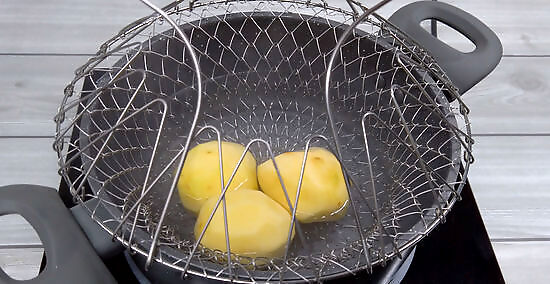
Submerge the potatoes in the boiling water and put on the blanching lid. Slowly lower the basket into the water, being careful not to burn yourself. Then, secure the lid on top. You may notice that the water stops boiling for a moment after you add the potatoes. Watch for it to return to a boil. The water should start boiling again in 1 minute. If it doesn’t, you may have added too many potatoes. If you're not using a blanching basket, use a slotted spoon or tongs to gently lower the potatoes into the water 1 by 1. Be careful not to splash, as the water can scald your skin.
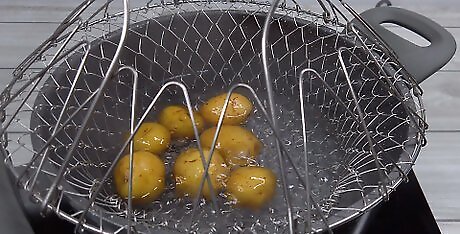
Blanch small potatoes for 3-5 minutes or large potatoes for 8-10 minutes. Potatoes that are about 1.5 inches (3.8 cm) or smaller are considered small, and potatoes that are larger than this are considered large. However, potatoes that have been cut should be treated as small potatoes. Set a timer so you can keep track of the cooking time.Did You Know? Blanching helps preserve your potatoes in several ways. It will halt enzymes inside the potatoes to preserve the best flavor, texture, and color. Additionally, it gets the potatoes very clean and helps preserve their vitamin content.
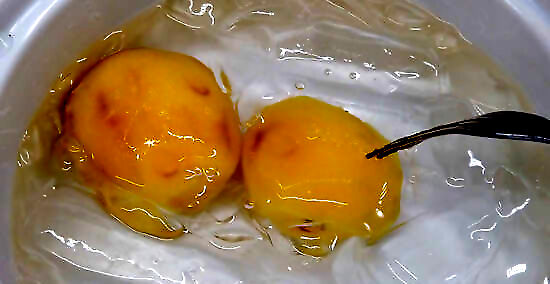
Remove the potatoes from the heat and plunge them into ice water. This stops the cooking process and preserves the potatoes as they are. Lift the blanching basket out of the boiling water, then place it directly into an ice bath. Cool them for the same amount of time that you blanched them. If you’re not using a blanching basket, use a slotted spoon or tongs to transfer your potatoes from the water to the ice bath. Small potatoes will cool for 3-5 minutes, while large potatoes will cool for 8-10 minutes.Tip: For best results, your water should be at least 60 °F (16 °C) or below to quickly cool the potatoes.
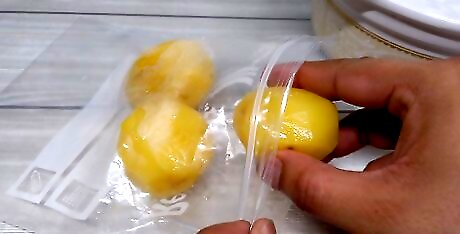
Put the potatoes in an airtight container and freeze them. Use a plastic bag with a zipper or a plastic food storage container. Leave about .5 inches (1.3 cm) of space inside the container. Label the container with the contents and date they were frozen. Then, put the container in your freezer. It’s a good idea to pre-portion your potatoes so that you’ll have enough for 1 meal in each bag. You can store your potatoes in the freezer for about 12 months. Be sure to write the date on the container so you can keep track of how long they've been in the freezer.Variation: If you’re freezing potatoes cut for french fries, toss them with oil right before you put them in the airtight container. Place the slices in a bowl, then add about 1 tablespoon (15 mL) of vegetable oil for every 2 pounds (0.91 kg) of potatoes. Toss until the potato slices are coated in oil. This will make them easier to cook.
Defrosting and Cooking Your Potatoes
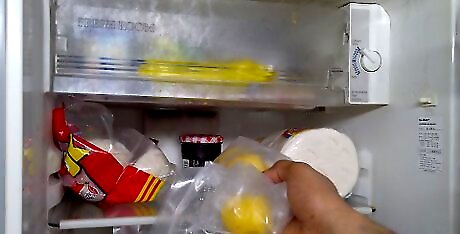
Thaw raw or prepared potatoes for 1-2 days in your refrigerator, if you have time. Remove your potatoes from the freezer. Place them in their airtight container directly into your refrigerator. Let them sit for 1-2 days before cooking them. This gives them time to defrost. If you only want to defrost a small amount of potatoes, remove them from the airtight container and place them in a separate airtight container for defrosting.Tip: If you need to chop your potatoes before you cook them, it’s best to defrost them. Otherwise, they’ll be hard to chop.
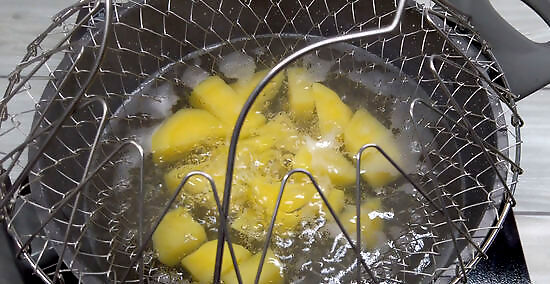
Cook the potatoes without thawing them if you’re short on time. Although your cook time may take an extra 1-2 minutes, your potatoes will cook just fine directly from the freezer. Simply take them from the freezer and place them onto your baking sheet or into your pot. Then, cook as you normally would. The potatoes will defrost quickly once they start cooking. This works for both raw and cooked potatoes.
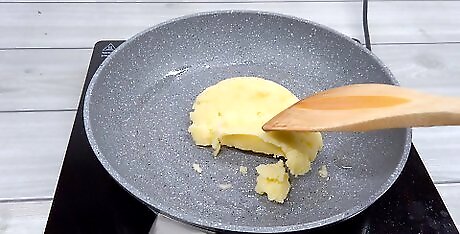
Heat prepared mashed potatoes over medium-high heat until warm. Put the potatoes into a pot over medium-high heat. Stir the potatoes occasionally as they cook. Then, add additional ingredients or garnishes, as desired. You can also heat the potatoes in a covered dish in the oven at 350 °F (177 °C) for about 30 minutes. Spread them in a single even layer to minimize drying out and let them warm faster. To cook them in a microwave, heat them in a covered dish at half power for about 5 minutes. Check them, then heat on high in 30 second intervals until they’re warm. When you heat prepared mashed potatoes, they lose moisture unavoidably. To compensate for this loss, add more cream and butter. If you want to add moisture with less fat, use half and half or some nutrient-dense broth.
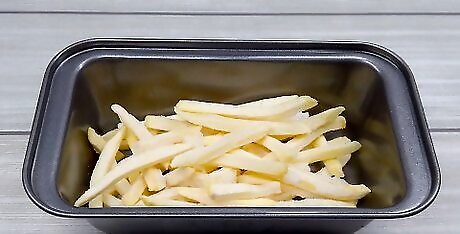
Bake frozen french fries at 450 °F (232 °C) for 20-25 minutes. Spread the frozen fries out on your greased baking sheet. Then, put them into the preheated oven for 20-25 minutes. Flip them about halfway through baking. Eat the fries while they’re warm. Cooked fries only need to heat for about 5-15 minutes. Check them often to make sure they don’t burn.Variation: Fry the french fries in vegetable oil heated to 350 °F (177 °C) for 3-4 minutes or until crispy.
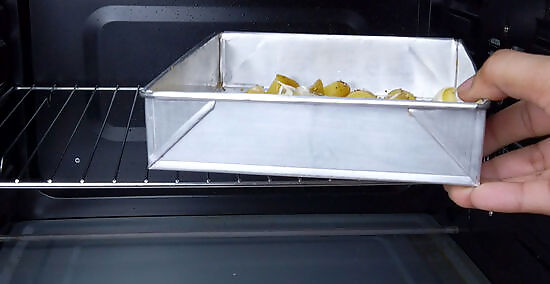
Roast potatoes at 425 °F (218 °C) for 35 minutes. Use a sharp knife to chop the potatoes into bite-sized chunks. Put the potatoes in a bowl and toss them with seasonings, such as olive oil, salt, and pepper. Spread the potatoes out on a baking sheet that’s covered in aluminum foil or a non-stick cooking spray. Put the potatoes in the oven, then cook them for 35 minutes, tossing partway through. Garlic, thyme, rosemary, and chili pepper are also great seasoning choices. If you don’t have aluminum foil or cooking spray, wipe your pan down with a thin coating of olive oil to keep your potatoes from sticking.
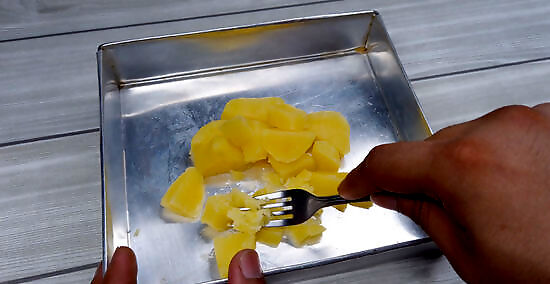
Make mashed potatoes by boiling potato chunks, then mashing them. Use a sharp knife to chop the potatoes, then put them in a large pot and cover them with water. Put a lid on the pot, then heat the water to a boil over medium-high heat. Boil the potatoes for about 16-18 minutes, then remove them from the heat and drain them. Add a stick of butter, .5 cups (120 mL) of milk, and a dash of salt and pepper. Use a potato masher to mix the ingredients together until they’re smooth, then serve. To check if your potatoes are ready to mash, see if they feel tender when you push a fork through them. If you have an electric mixer, you can use it instead of a potato masher. Spice up your mashed potatoes by adding additional seasonings, sour cream, cheese, chives, or green onions.
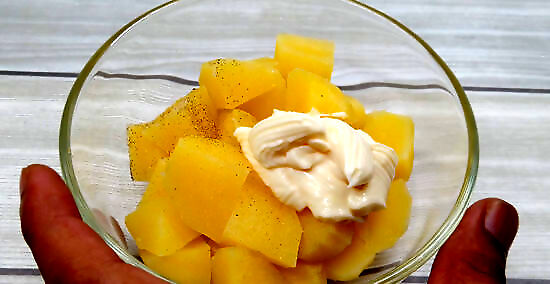
Make potato salad by boiling the potatoes and mixing in garnishes. Chop up the potatoes, put them in a pot, and cover them with water. Bring the water to a boil over high heat, then cook for about 15 minutes. Drain the potatoes over a colander, then let them cool for about 10 minutes. In a separate bowl, combine .5 cups (120 mL) of mayonnaise, 2 tablespoons (30 mL) of vinegar, 2 teaspoons (9.9 mL) of dijon mustard, 2 sliced scallions, 2 tbsp (5 g) parsley, 1 diced celery rib, and a dash of salt and pepper. Stir in the potatoes and serve. You can cut your potatoes before or after you boil them. If you’re cooking your potatoes from frozen, this is the best option. If you like, you can add chopped hard boiled egg to your potato salad.


















Comments
0 comment